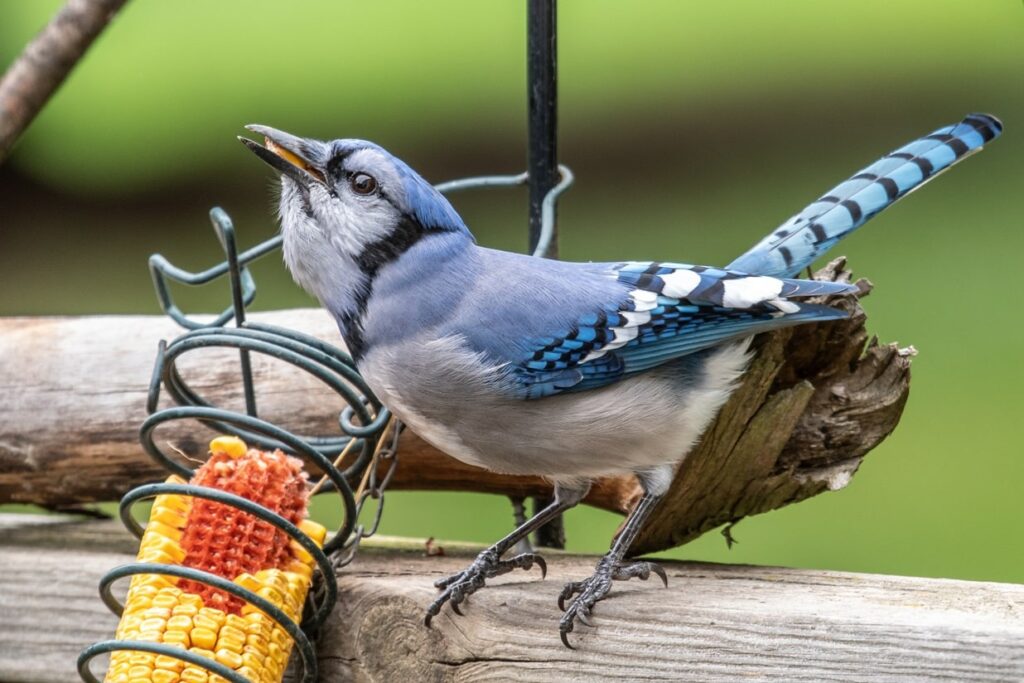Attracting bluejays to your yard is easy when you put out the right food sources. Since bluejays are adaptable birds, they can eat a varied diet. So, what foods do they eat?
Bluejays are omnivores, which means they can eat a variety of foods. They prefer to eat nuts and seeds. Peanuts and sunflower seeds are their favorite foods to eat, but their diets aren’t limited. These birds will also eat berries, insects, and flower blossoms.
Since bluejays don’t migrate to different areas, they adapt to the food sources that are available to them. This means that they will eat different foods in different seasons.
Bluejays are also known to get creative when they’re searching for food. They have even been spotted eating the larvae from wasps’ nests. Their robust bills help them break apart foods that appear difficult to eat. This is part of the reason why they are able to have a wide variety of foods in their diet.

What Do Bluejays Eat In Winter?
Unlike other birds, Bluejays don’t fly south for winter. Instead, they find safe areas and gather thick foliage to make a warm nest for the season. It’s unlikely that you will see these birds searching for food as frequently as they do during warmer months.
This is because bluejays will prepare for the winter season ahead of time. In the fall, they will collect food caches to get them through the winter season. Nuts are a preferred food source to get them through winter. This includes hickory nuts, acorns, hazelnuts, beechnuts, and more.
Bluejays have a gular pouch. They store food in the pouch to feed on later. This is why they can clear a feeder and come back for more.
While bluejays prepare for the season ahead of time, they still go out looking for food in the winter. Since natural resources are slim this time of year, they will go to properties with winter bird feeders. They will also eat any scraps of food people leave out for them.
What Do Bluejays Eat In The Spring?
Bluejays have an easier time finding food from spring through autumn when everything has thawed. This is because the bluejays’ diet consists mainly of plants. They prefer nuts, seeds, grains, berries, and other small fruits. They will even eat the blossoms or leaves off of plants.
Since bluejays are omnivores, their diet consists of both plants and animals. The protein sources they typically eat are insects and invertebrates, which are more abundant in warm weather. Eating small animals isn’t standard, however, these birds have been known to eat mice, frogs, and other small critters.
Other birds aren’t safe when a hungry bluejay is on the prowl. They are known to fly by other birds’ nests and eat eggs.
Do Bluejays Eat Out Of Feeders?
Bluejays will eat out of bird feeders. They have a good sense of food, especially peanuts. People that have put peanuts in their bird feeders have noticed that it doesn’t take long for a flock of bluejays to find their yard.
One of the things that make bluejays unique is their intelligence. This gives them an edge when they’re searching for food and intimidating any competition for that food. If you put something in the feeders that bluejays like, they are very likely to bully the other birds away.
A group of bluejays could clear out a whole feeder of food within a few minutes. They can store a lot of nuts and seeds in their cache. Male bluejays are also known to bring caches of food from the feeder back to the nest for the female and baby birds.
While bluejays will take food from any feeders, they prefer a standing feeder. It’s easier for them to grab food from a tray or hopper feeder. They have a difficult time getting food from hanging feeders.
What Do Bluejays Eat At The Feeder?
A great choice for the bird feeder is suet if you want to feed bluejays, especially in the winter. Suet is a mixture of seeds, oats, dried fruits, and other food sources birds enjoy. They are compacted into a block with rendered animal fat holding it all together. Bluejays (and other birds) can pick away at it, piece by piece, to get food.
You can put nuts, oats, and seeds in the feeder for the bluejays. However, this can become expensive if you plan to feed them on a daily basis. For example, if you place shelled peanuts in the feeder, the bluejays will continue taking the nuts until the feeder is empty. They can empty a bird feeder in under half an hour.
Bird seed mixes are a less expensive option. There are many types of birdseed mixes on the market. We suggest choosing one with large seeds if you want more bluejays in your yard.
Should I Feed Bluejays?
It’s perfectly fine to feed the bluejays. Once they know a food source is there, they will continue to come back for it. The biggest problem will be how expensive it is to feed them. If you want to continuously feed the bluejays without burning a hole in your wallet, we suggest planting something they will enjoy.
Acorns are another favorite food for these birds. If there is an acorn tree in your yard, they will continue coming back to feed off of it. Nut trees, like hazelnut or walnut, are also a great choice for attracting more of these gorgeous birds.
